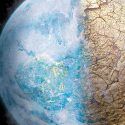A volcano starts rumbling, and suddenly erupts. But instead of seeing lava trickling down, you see a massive cloud of ash quickly coming towards you. This isn’t just any regular volcano explosion. Instead, it’s a pyroclastic flow.
It can wipe out entire cities in minutes, killing thousands of people. And now, one’s coming for you.
Every time a volcano erupts, there’s a chance of a pyroclastic flow. It can happen when a volcano is damaged during an eruption, or the lava shoots upwards, and then collapses.
When this happens, a massive avalanche of smoke comes tumbling down the volcano. It’s made of ash, rocks, and poisonous gases that can move up to 700 kph (450 mph).
I know, the odds of surviving this episode may seem impossible. But believe it or not, people have managed to survive a pyroclastic flow. What can you wear to help you survive?
Where is the safest place to find shelter? And how have people survived this before?
Number 1 – Evacuate as quickly as possible.
If you’re near an active volcano, and you see a pyroclastic flow, you need to start moving immediately. Hop in your car, and follow the evacuation instructions. A pyroclastic flow is a lot more dangerous than a lava flow, since it can travel up to 100 km (62 mi) away from its original position. So start driving fast if you want to survive this.
Number 2 – Wear protection
You should still be driving your car at this point, but if the pyroclastic flow gets near you, you’ll begin to feel the heat. These things can be as hot as 700°C (1,300°F). In order to help you survive this heat, you’ll want to put on some protective gear.
Luckily for you, the University of Missouri has been developing suits to withstand the heat of volcanoes. It uses flame resistant Kevlar® and breathable fabric. Wearing this can help you withstand the incredibly hot temperatures.
Number 3 – Seek shelter
If you can’t get far enough away to avoid the flow, then you’re going to need to find shelter. And we’re not talking about a house or a building. A pyroclastic flow can easily wipe those out. You’ll want to find an underground bunker, cave, or even a parking garage if you can go down to a low enough floor.
This is how a prisoner survived a pyroclastic flow in 1902. While an entire city was being burned, Ludger Sylbaris sat in an underground jail cell with bomb-proof walls. Days later, he was found underground with severe burns all over his body, but he managed to survive. Although this won’t completely protect you from the heat and the gases, it’s still your best strategy for staying alive.
Number 4 – Wait in your shelter
While you’re in your shelter, your first instinct may be to hop out quickly. After all, being inside this shelter will be incredibly hot, and there’s a chance that ash can leak in, making it difficult to breathe. But if possible, try not to leave your shelter right away.
If you think it’s bad inside your shelter, imagine what it will be like outside. Expect to find destroyed buildings, massive fires everywhere, and ash so thick you can barely see. These are just a few of the things you’ll have to worry about. Once a day or so passes, you should be able to leave your shelter safely.
Number 5 – Seek medical attention.
Congratulations! You didn’t die. But that doesn’t mean you’re walking out of this unscathed. While you were in that bunker, you likely suffered severe burns all over your body, due to the heat of the pyroclastic flow.
Not only that, but you’ll also experience breathing problems from inhaling the ash. As soon as you leave your bunker, you’ll need to go to a hospital immediately. There, they can treat your burns and any other injuries you might have.
Number 6 – Listen to instructions.
Sure, you managed to survive this scenario, but it wasn’t without consequences. These burns and lung issues might last for the rest of your life. Is there a way to avoid all this? Well, listen to instructions if an active volcano is about to explode. Usually, we’re pretty good at predicting these things, and can make sure people are far enough away from the explosion so that no one gets injured. That way, you can still see the incredible sights without getting burned.
Sources
- “Pyroclastic Flows”. 2020. geo.mtu.edu.
- “Pyroclastic Flow | Definition, Examples, & Facts”. 2020. Encyclopedia Britannica.
- “USGS: Volcano Hazards Program “. volcanoes.usgs.gov.
- “Mount Vesuvius Boiled Its Victims’ Blood And Caused Their Skulls To Explode”. Smithsonian Magazine.
- “When Mount Pelee Exploded (Part 2)”. 2011. Providentia.
- “Breathable Lava Suits: Volcanologist Field-Tested And Approved”. 2020. phys.org.




























Hot topics !!